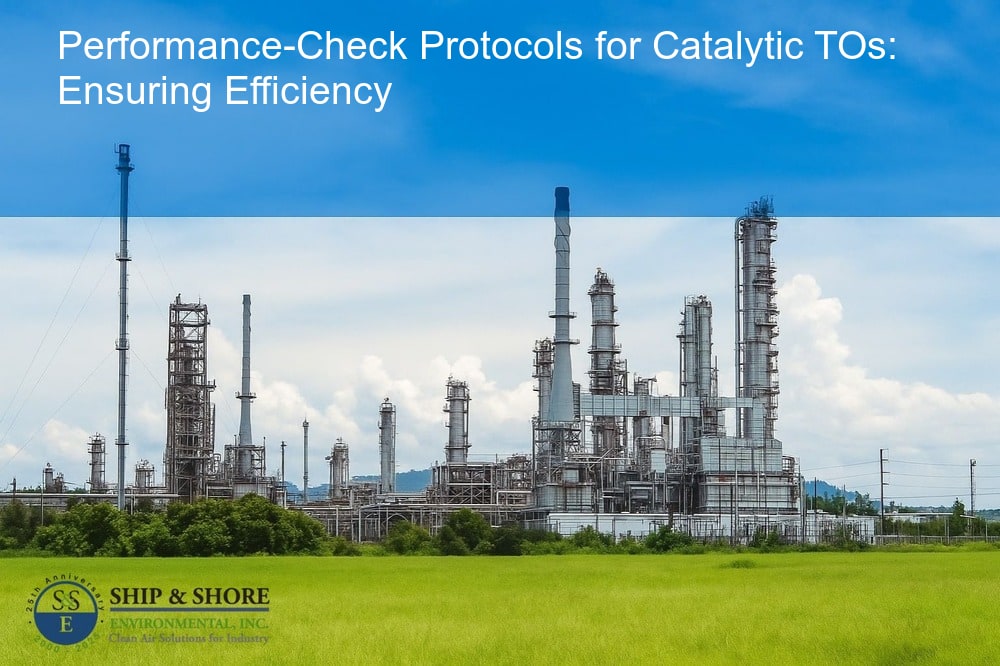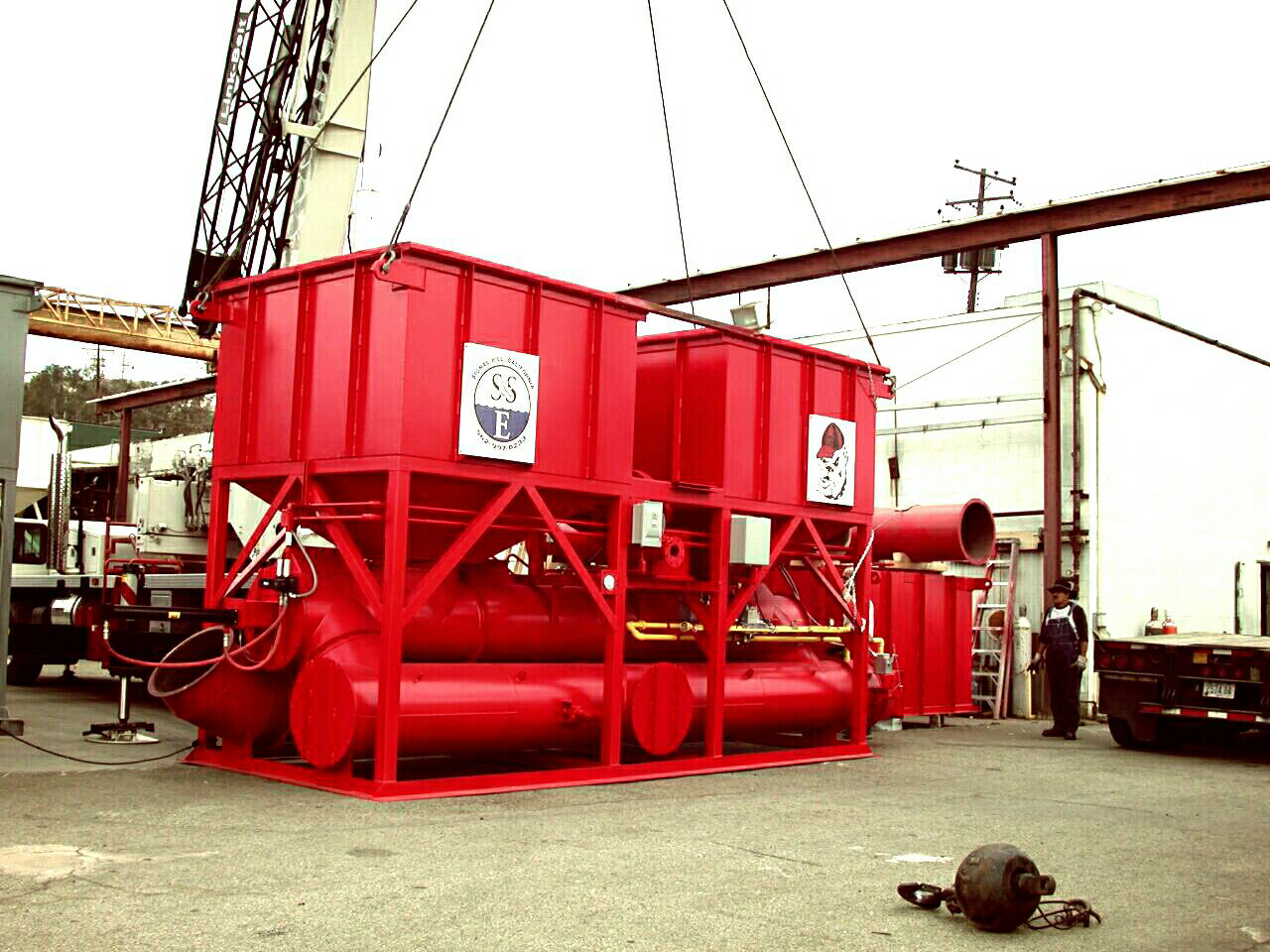
Mastering Performance-Check Protocols for Catalytic TOs
August 15, 2025 2:09 amSetting the Stage: Importance of Catalytic Thermal Oxidizers
At Ship & Shore Environmental, Inc., we recognize the critical role that catalytic thermal oxidizers (TOs) play in air pollution control strategies. Performance-check protocols for catalytic TOs are essential to ensure these systems operate at peak efficiency, reducing hazardous emissions and complying with environmental regulations. Catalytic TOs are sophisticated devices that leverage catalysts to facilitate the oxidation of volatile organic compounds (VOCs) at lower temperatures, thereby saving energy and reducing operational costs. As industries strive to uphold rigorous environmental standards, the need for robust performance-check protocols has never been more paramount.
Primer: Basics of Performance-Check Protocols
Performance-check protocols are systematic procedures designed to evaluate the efficiency and functionality of catalytic TOs. These protocols encompass a wide range of activities, from routine inspections to comprehensive performance evaluations, ensuring all components of the oxidizer are operating correctly. The purpose of these checks is to identify potential issues before they escalate into significant problems, thereby extending the lifespan of the equipment and maintaining compliance with emission regulations. A thorough understanding of these protocols empowers operators to maintain optimal performance and ensure the longevity of their catalytic TO systems.
Looking Ahead: Exploring the Contents of This Blog
In the following sections, we will delve into the intricacies of performance-check protocols for catalytic TOs, unpacking their mechanics and significance. We aim to provide a detailed, easy-to-understand guide that highlights not only the operational aspects but also the strategic importance of adhering to these protocols. Our discussion will encompass real-world case studies that illustrate successful implementations, helping you grasp practical applications and benefits. By offering insights from these examples, we hope to underscore the transformative impact that meticulous performance-check protocols can have on your catalytic TO systems.
Diving Deeper: How Performance-Check Protocols for Catalytic TOs Work
Effective performance-check protocols for catalytic thermal oxidizers (TOs) start with an understanding of the fundamental components at play. Catalytic TOs are essential for reducing harmful emissions by converting volatile organic compounds (VOCs) into harmless gases. Therefore, ensuring these systems operate efficiently is crucial.
Performance-check protocols involve a series of meticulous steps designed to test and verify the operational effectiveness of catalytic TOs. These protocols typically include assessing catalyst activity, checking combustion efficiency, and measuring exhaust emissions. Each step in these protocols ensures that every aspect of the catalytic TOs operates as intended, maintaining optimal performance and compliance with environmental regulations.
Making it Operational: Importance of Adhering to Performance-Check Protocols
Adhering to performance-check protocols for catalytic TOs is pivotal for a variety of reasons. Firstly, these protocols help detect potential issues before they escalate into major problems. Regular checks can identify minor faults, allowing for timely maintenance activities that prevent costly shutdowns. Secondly, adherence ensures compliance with stringent environmental standards, thereby avoiding penalties and fostering a safer environment. Furthermore, routine checks contribute to the longevity and durability of the catalytic TOs, helping operators get the most out of their investment.
Neglecting performance-check protocols can lead to significant drawbacks, such as increased operational costs due to inefficiencies and risks of non-compliance with environmental standards. By prioritizing and adhering to these protocols, we enhance both the operational and environmental performance of our catalytic TOs.
Case Studies: Successful Implementation of Performance-Check Protocols for Catalytic TOs
Several case studies underscore the benefits of stringent performance-check protocols for catalytic TOs. For example, a large manufacturing plant that implemented rigorous protocol adherence saw a 15% improvement in VOC conversion efficiency. The plant followed a detailed checklist that included:
- Regular catalyst activity assessments
- Routine combustion efficiency tests
- Periodic exhaust emissions measurements
- Scheduled maintenance of key components
Another noteworthy case involved a chemical processing facility that faced frequent operational interruptions due to overlooked maintenance needs. After adopting comprehensive performance-check protocols, the facility experienced a significant reduction in unplanned downtime and a marked improvement in emissions control.
These case studies illustrate the tangible benefits of diligently following performance-check protocols for catalytic TOs. Moreover, they highlight how adherence not only enhances operational efficiency but also contributes to sustainable practices by reducing harmful emissions. Through these examples, we see that investment in these protocols pays dividends in reliability, efficiency, and regulatory compliance.
Did you know? Adhering to performance-check protocols for Catalytic Thermal Oxidizers (TOs) can significantly increase operational efficiency and prevent emission violations.
Lessons from the successful implementation of performance-check protocols
Performance-check protocols for catalytic TOs have proven themselves crucial in maintaining operational efficiency, sustainability, and compliance. Through our extensive experience, we’ve consistently observed the tangible benefits these protocols offer. By ensuring regular and thorough checks, we’ve mitigated potential issues before they evolve into serious problems, thus extending the operational lifespan of our equipment.
One of the most significant lessons we’ve learned is the importance of customization. No two catalytic thermal oxidizers are exactly alike, and neither should be their performance-check protocols. Tailoring these protocols to specific operational demands enables better accuracy and effectiveness. Case studies from our clients demonstrate how customized solutions lead to optimal performance and customer satisfaction.
Anticipating future developments in catalytic TO performance checks
As we look toward the future, we can anticipate several developments in the realm of performance-check protocols for catalytic TOs. Technological advancements are poised to revolutionize how we monitor and validate the performance of our systems. Improved sensor technologies and advanced data analytics will likely play significant roles. These innovations will make it possible to conduct more precise and real-time assessments, thereby elevating the reliability and effectiveness of our protocols.
Additionally, we foresee regulatory standards becoming increasingly stringent, necessitating even more rigorous performance-check protocols. Staying ahead of these changes will be vital for continued compliance and operational efficiency. Continued professional development and investment in cutting-edge technology will keep us prepared for these shifts.
Final thoughts on performance-check protocols for catalytic TOs
The journey through understanding and implementing performance-check protocols for catalytic TOs has underlined their indispensability in the realm of environmental engineering. Rigorous, well-tailored performance checks are not just a regulatory requisite but a fundamental aspect of responsible and efficient operation. Moving forward, our commitment to innovation and customization will ensure that we continue to meet and exceed industry standards.
Embracing these protocols with a forward-thinking mindset will enable us to navigate the future landscapes of technology and regulation effortlessly. With our expertise and dedication, we are confident in our ability to lead in the development and implementation of the next generation of performance-check protocols for catalytic TOs.
FAQ
What makes performance-check protocols so crucial for catalytic thermal oxidizers?
Performance checks are essential to ensure that catalytic thermal oxidizers operate efficiently, comply with regulations, and sustainably manage emissions. By adhering to these protocols, we can prevent issues from escalating into costly problems, thereby extending the life span and effectiveness of our equipment.
How are catalytic oxidizer performance checks tailored to individual needs?
Customization is key. Recognizing that each system has unique operational requirements, we craft protocols to align with specific performance criteria. This ultimately leads to more accurate assessments and maximizes the efficiency and longevity of the thermal oxidizers we service.
Can you share insights from case studies on the successful implementation of these protocols?
Our case studies highlight the positive outcomes from tailored performance checks, with our clients experiencing enhanced system performance and satisfaction. Through these real-world applications, we’ve reinforced the value of proactive maintenance and personalized approach to performance monitoring.
How will advances in technology impact performance checks in the future?
Technological advancements are anticipated to greatly improve how we conduct performance evaluations. The integration of enhanced sensors and data analytics will offer precise, real-time insights, thus elevating the reliability and thoroughness of our performance checks. These improvements will pave the way for even more effective monitoring protocols.
With evolving regulations, how will performance checks adapt to ensure compliance?
Given the likelihood of stricter regulatory standards, performance checks will need to become more rigorous. Our commitment to staying abreast of regulatory trends and investing in the latest technologies positions us to meet these evolving standards while maintaining operational excellence.
Categorised in: Blog

